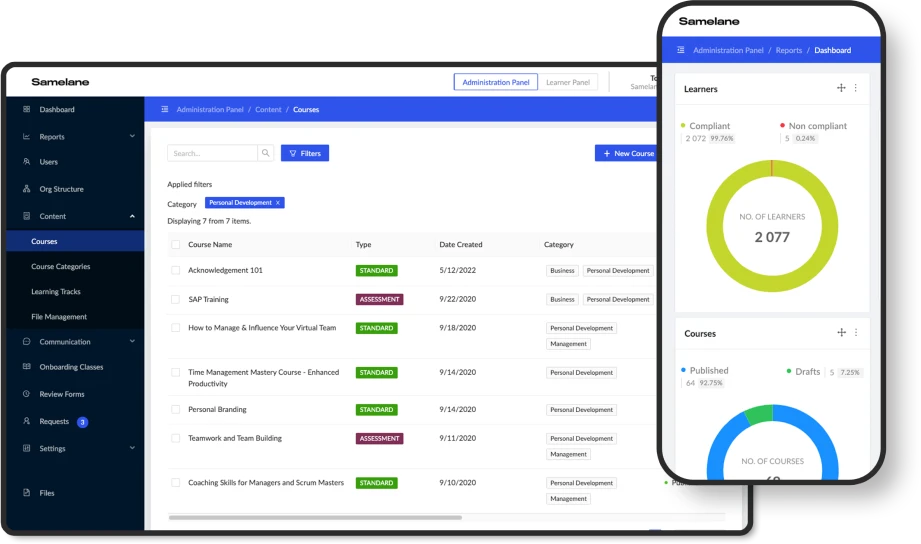Blended learning has revolutionized the education landscape, combining the best of online and in-person learning experiences. By integrating digital tools and resources with traditional face-to-face instruction, blended learning offers a flexible and personalized approach to education. One key element that has greatly facilitated the implementation of blended learning is using Learning Management Systems. This article will explore some of the most practical examples of blended learning facilitated by LMS.
The purpose of blended learning
The main aim of b-learning is to combine the strengths of both online and in-person instruction to create a more effective and engaging learning experience. It seeks to leverage the advantages of technology and digital resources while preserving the benefits of face-to-face interaction and personalized guidance. In other words, blended learning aims to create a student-centered, flexible, and engaging learning environment that combines the advantages of online and in-person instruction. The goal is to meet the diverse needs of learners, promote active engagement and collaboration, and prepare students for the demands of the digital age.
Blended learning examples
Learning Management Systems can be effectively used for b-learning by providing a centralized platform for organizing, delivering, and managing various aspects of the learning experience. Here are some examples of how an LMS can be used for blended learning.
Content delivery and access
An LMS allows educators to upload and deliver course materials, including lecture videos, readings, and interactive modules, at the same time enabling multimodal learning. Students can access these resources at their own pace and review them as needed. In addition, the LMS provides a structured environment where learners can easily navigate and access content from any location, fostering flexibility and self-paced learning.
Discussion and collaboration
LMS platforms include discussion forums, chat rooms, and collaborative tools that enable students to interact with each other and the instructor. These communication channels promote engagement, peer-to-peer learning, and exchanging ideas, even in online or hybrid learning environments. Students can participate in discussions, ask questions, and share resources, enhancing the learning experience.

Assessments and feedback
LMS platforms offer tools for creating and administering online assessments, quizzes, and assignments. Educators can design formative and summative assessments to gauge students’ understanding and progress. The LMS automates grading processes and provides timely feedback to learners, allowing for immediate reinforcement or targeted remediation. Additionally, instructors can track student performance and identify areas for improvement.
Progress tracking and analytics
LMS platforms provide comprehensive analytics and reporting features. Educators can monitor student progress, track completion rates, and assess engagement levels. These insights help instructors identify struggling students, adjust instructional strategies, and provide targeted support. LMS analytics also offers data-driven insights into the effectiveness of blended learning approaches, allowing for continuous improvement and refinement.
Personalization and differentiation
An LMS allows educators to deliver personalized learning experiences. By leveraging the platform’s features, instructors can create individualized learning paths, recommend supplementary resources based on student’s performance, and provide tailored feedback. In addition, LMS platforms enable adaptive learning, ensuring that each student’s needs and learning pace are accommodated.
Mobile learning
Many modern LMS platforms are mobile-friendly, allowing learners to access course materials, participate in discussions, and submit assignments using smartphones or tablets. This mobility enhances the blended learning experience, enabling students to engage with content and interact with peers and instructors on the go. Mobile learning options provided by LMS platforms promote convenience and accessibility.
The benefits of blended learning powered by LMS
Blended learning, when facilitated by a Learning Management System, offers several benefits for educators and learners. An LMS provides a centralized platform for organizing and managing course materials, resources, and activities. The centralized approach simplifies content delivery and ensures consistency across the learning environment. Furthermore, LMS platforms enable learners to access course materials and resources anytime and from anywhere with an internet connection. It also facilitates learning outside traditional classroom settings, accommodating diverse learning needs and lifestyles. Learning platforms offer tools for personalizing the learning experience. The adaptability promotes personalized instruction, ensuring learners receive the support and challenges required to succeed.
Nextly, LMS platforms support various communication and collaboration features that foster student interaction and engagement. They facilitate effective communication and peer-to-peer learning, even in hybrid or fully online learning environments. Finally, platforms streamline the assessment process by providing automated grading, instant feedback, and tracking of student progress. Timely feedback supports students in understanding their strengths and areas for improvement, enhancing their learning outcomes.
Enable and enhance blended learning with an LMS
Blended learning, with the support of Learning Management Systems, has transformed education by combining the strengths of online and in-person learning. The examples mentioned above demonstrate the versatility and effectiveness of blended learning in various educational contexts. As technology continues to evolve, the potential for blended learning and its impact on education is boundless. LMS platforms provide a comprehensive solution for blended learning, offering features such as content delivery, communication and collaboration tools, assessment capabilities, progress tracking, personalization, and mobile learning support. By utilizing these functionalities, educators can create dynamic and engaging blended learning experiences for their students.










